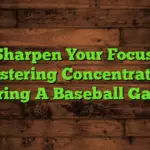Baseball is a demanding sport, both physically and mentally. Whether you’re a seasoned pro or a weekend warrior, intense games leave you feeling drained. This comprehensive guide will teach you everything you need to know about effectively cooling down after a baseball game, improving your recovery, and minimizing the risk of injury. We’ll cover hydration, nutrition, stretching, and even mental recovery strategies. You’ll learn how to optimize your post-game routine for peak performance in your next game.
Cooling down after a baseball game is crucial for several reasons. Intense physical activity increases your heart rate and body temperature. A proper cool-down gradually lowers these, preventing sudden drops that can lead to dizziness or fainting. It also helps flush out metabolic waste products from your muscles, reducing muscle
soreness (DOMS) and stiffness. Finally, it allows your body to transition smoothly from high-intensity activity back to rest.
Hydration: Replenishing Lost Fluids
The Role of Electrolytes
Baseball games often take place in hot and humid conditions, leading to significant fluid loss through sweat. Replenishing this loss is crucial. Plain water is important, but sports drinks containing electrolytes like sodium and potassium are even better, as they help restore the balance lost during intense activity. Consider electrolyte tablets if you dislike the sugary taste of sports drinks.
Nutrition: Fueling Your Recovery
The Importance of Post-Game Nutrition
Your body needs nutrients to repair muscle tissue after a strenuous game. Consume a balanced meal or snack within 30-60 minutes of finishing, focusing on a combination of carbohydrates for energy replenishment and protein for muscle repair. Examples include a banana with peanut butter, a chicken salad sandwich, or a protein shake.
Active Recovery: Gentle Movement and Stretching
Active Recovery vs. Passive Recovery
Active recovery involves light exercise like walking or cycling after a baseball game. This improves blood flow to your muscles, promoting faster recovery. Passive recovery, on the other hand, involves complete rest. While both have their place, active recovery is generally better for faster recovery and reduced soreness.
Static Stretching: Lengthening Tight Muscles
Key Stretches for Baseball Players
Static stretching involves holding a stretch for 15-30 seconds. Focus on areas commonly used in baseball, such as hamstrings, quads, calves, shoulders, and back. Examples include hamstring stretches, quad stretches, calf raises, shoulder rotations, and torso twists. Gentle stretching improves flexibility and reduces the risk of future injuries.
Dynamic Stretching: Improving Range of Motion
Dynamic Stretches Before Static Stretches
Dynamic stretching involves movement-based stretches, preparing your body for more intense activity. Although often performed before a game, gentle dynamic stretches post-game can also improve circulation and flexibility. Arm circles, leg swings, and torso twists are effective examples.
Foam Rolling: Releasing Muscle Tension
Techniques for Effective Foam Rolling
Foam rolling is a form of self-myofascial release, helping to alleviate muscle stiffness and tightness. Roll slowly and deliberately over your muscles, focusing on any areas of particular tension. Pay special attention to your legs, back, and shoulders.
Ice Baths and Cold Therapy: Reducing Inflammation
When and How to Use Cold Therapy
Ice baths or cold packs can reduce inflammation and swelling after a game. Immerse yourself in an ice bath for 10-15 minutes, or apply ice packs to specific areas for 15-20 minutes at a time. Be sure to avoid direct skin contact with the ice packs.
Sleep: Rest and Recovery
Importance of Quality Sleep
Sufficient sleep is essential for muscle repair and overall recovery. Aim for 7-9 hours of quality sleep each night. Establish a regular sleep schedule, creating a relaxing bedtime routine to improve sleep quality.
Mental Recovery: Stress Reduction Techniques
The Importance of Mental Well-being
Baseball can be mentally demanding, requiring focus and concentration. After a game, practice relaxation techniques like deep breathing or meditation to reduce stress and improve mental recovery.
Long-Term Strategies: Injury Prevention
Proactive Measures for Optimal Health
Implementing long-term strategies like consistent training, proper nutrition, and adequate rest minimizes the risk of injuries and enhances overall well-being. Regular physical therapy sessions and proper warm-up routines are also very effective. Consult with a physical therapist for guidance.
Monitoring Your Body: Recognizing Signs of Overtraining
Identifying and Addressing Warning Signs
Pay close attention to your body. Signs of overtraining include persistent fatigue, muscle soreness, decreased performance, and mood changes. If you experience any of these, reduce your training intensity or take a complete rest day.
Comparing Different Cool-Down Methods
Tailoring Your Routine to Your Needs
The best cool-down method depends on individual needs and preferences. Some players may prefer active recovery, while others might find passive recovery more beneficial. Experiment with different techniques to determine the most effective approach for your body.
Professional Guidance: Seeking Expert Advice
When to Consult a Professional
If you experience persistent pain, swelling, or other concerning symptoms, consult a physician or physical therapist. They can diagnose any injuries and recommend appropriate treatment options.
Utilizing Technology for Recovery
Smartwatches and Fitness Trackers
Smartwatches and fitness trackers can monitor your heart rate, sleep patterns, and activity levels, providing valuable data to optimize your recovery strategy. This allows for better understanding of your body’s response to exercise and allows for customization of the recovery strategy.
Nutrition Apps and Resources
Planning and Tracking Your Diet
Nutrition apps and online resources can help you create a balanced meal plan tailored to your needs and goals. They provide information on macro and micronutrients and can help you track your daily intake, ensuring adequate nutrition for recovery.
Setting Up a Post-Game Recovery Routine
Creating a Personalized Plan
Develop a personalized post-game recovery routine that includes hydration, nutrition, stretching, and relaxation techniques. Maintain consistency with your routine to maximize its effectiveness.
Frequently Asked Questions
What is the best way to hydrate after a baseball game?
The best way to hydrate after a baseball game is to drink plenty of water or an electrolyte beverage to replace fluids and electrolytes lost through sweat. The amount needed varies based on factors like the duration and intensity of the game and environmental conditions.
How long should I stretch after a game?
Aim for 10-15 minutes of stretching post-game, focusing on major muscle groups used during the game. Holding each stretch for 15-30 seconds is generally recommended.
How often should I foam roll?
Foam rolling can be done daily or every other day, depending on your individual needs and recovery progress. Listen to your body and adjust the frequency accordingly.
Is it necessary to take ice baths?
Ice baths are not strictly necessary, but they can be beneficial for reducing inflammation and muscle soreness. The effect is primarily subjective, and some athletes find them more helpful than others.
What should I eat after a baseball game?
Focus on a balanced meal or snack containing carbohydrates and protein within 30-60 minutes post-game. Good examples include chicken and rice, Greek yogurt with fruit, or a protein shake with banana.
How much sleep do I need for optimal recovery?
Aim for 7-9 hours of quality sleep per night. This allows your body to repair muscle tissue and restore energy levels for the next game or practice.
What are the signs of overtraining?
Signs of overtraining include persistent fatigue, increased muscle soreness, decreased performance, irritability, and changes in mood. If you notice these, reduce your training volume or take a break.
Final Thoughts
Cooling down effectively after a baseball game is not just about addressing immediate fatigue; it’s about long-term health and performance optimization. By following the guidelines outlined in this guide—focusing on hydration, nutrition, active and static stretching, and adequate rest—you can significantly improve your recovery process, reduce the risk of injuries, and enhance your overall baseball experience. Remember, consistency is key. Incorporate these strategies into your regular routine, listen to your body, and adjust your approach as needed. Prioritizing your recovery is an investment in your continued success and enjoyment of the game.
Don’t wait until you’re injured to prioritize your recovery. Start implementing these strategies today and experience the difference a well-structured post-game routine can make. Remember to consult with a healthcare professional if you have any concerns or specific medical conditions.





